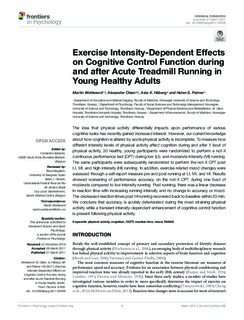| dc.contributor.author | Wohlwend, Martin Rainer | |
| dc.contributor.author | Olsen, Alexander | |
| dc.contributor.author | Håberg, Asta | |
| dc.contributor.author | Palmer, Helen | |
| dc.date.accessioned | 2017-06-01T07:52:38Z | |
| dc.date.available | 2017-06-01T07:52:38Z | |
| dc.date.created | 2017-05-18T18:13:11Z | |
| dc.date.issued | 2017 | |
| dc.identifier.issn | 1664-1078 | |
| dc.identifier.uri | http://hdl.handle.net/11250/2444045 | |
| dc.description.abstract | The idea that physical activity differentially impacts upon performance of various cognitive tasks has recently gained increased interest. However, our current knowledge about how cognition is altered by acute physical activity is incomplete. To measure how different intensity levels of physical activity affect cognition during and after 1 bout of physical activity, 30 healthy, young participants were randomized to perform a not-X continuous performance test (CPT) during low (LI)- and moderate intensity (MI) running. The same participants were subsequently randomized to perform the not-X CPT post LI, MI, and high intensity (HI) running. In addition, exercise related mood changes were assessed through a self-report measure pre and post running at LI, MI, and HI. Results showed worsening of performance accuracy on the not-X CPT during one bout of moderate compared to low intensity running. Post running, there was a linear decrease in reaction time with increasing running intensity and no change in accuracy or mood. The decreased reaction times post HI running recovered back to baseline within 20 min. We conclude that accuracy is acutely deteriorated during the most straining physical activity while a transient intensity-dependent enhancement of cognitive control function is present following physical activity. | nb_NO |
| dc.language.iso | eng | nb_NO |
| dc.publisher | Frontiers Media | nb_NO |
| dc.rights | Navngivelse 4.0 Internasjonal | * |
| dc.rights.uri | http://creativecommons.org/licenses/by/4.0/deed.no | * |
| dc.title | Exercise Intensity-Dependent Effects on Cognitive Control Function during and after Acute Treadmill Running in Young Healthy Adults | nb_NO |
| dc.type | Journal article | nb_NO |
| dc.type | Peer reviewed | nb_NO |
| dc.source.journal | Frontiers in Psychology | nb_NO |
| dc.identifier.doi | 10.3389/fpsyg.2017.00406 | |
| dc.identifier.cristin | 1470913 | |
| dc.description.localcode | This Document is Protected by copyright and was first published by Frontiers. All rights reserved. it is reproduced with permission. Copyright © 2017 Wohlwend, Olsen, Håberg and Palmer. This is an open-access article distributed under the terms of the Creative Commons Attribution License(CC BY). The use, distribution or reproduction in other forums is permitted,provided the original author(s) or licensor are credited and that the original publication in this journal is cited, in accordance with accepted academic practice.No use, distribution or reproduction is permitted which does not comply with these terms | nb_NO |
| cristin.unitcode | 194,65,25,0 | |
| cristin.unitcode | 194,67,40,0 | |
| cristin.unitcode | 194,65,30,0 | |
| cristin.unitname | Institutt for sirkulasjon og bildediagnostikk | |
| cristin.unitname | Psykologisk institutt | |
| cristin.unitname | Institutt for nevromedisin | |
| cristin.ispublished | true | |
| cristin.fulltext | original | |
| cristin.qualitycode | 2 | |

